Home > About Us > Sustainability Management > Sustainability Report > Sustainability Report 2015 > Promoting Resource Recycling
 Promoting Resource Recycling
Promoting Resource Recycling
In order to make effective use of limited resources, the Kobe Steel Group implements measures to control waste at each of its offices and plants.
We add value to byproducts created during manufacturing processes, develop new applications for materials and actively pursue recycling. Additionally, we also reduce waste during shipping by simplifying packaging methods and introducing lighter weight packaging throughout the Group.
We are also working to reduce paper consumption at offices by proactively digitizing meeting materials and introducing IT throughout the Group.
Promoting Waste Control and Recycling
![]()
In fiscal 2014 a total of 5.36 million tons of byproduct materials were created by the Kobe Steel Group, including overseas Group companies, with approximately 98.5 percent of those coming materials from the Iron & Steel Business. At the steelworks, we strive to recycle and add value to secondary materials produced during iron and steelmaking such as slag* and dust. In fiscal 2014 the recycling ratio for all of Kobe Steel was 97.3 percent, while the overall ratio for the Kobe Steel Group, including overseas Group companies, was 97.9 percent.
In addition to recycling, we also follow a fundamental policy of reducing the volume of waste generated through thorough adjustments to the amount of raw materials and auxiliary materials used.
Throughout the Kobe Steel Group, including overseas companies, Kobe Steel consigned 110,000 tons of waste to landfills. We plan to continue to reduce this amount through measures such as controlling the amount of waste generated, increasing recycling, developing new recycling technologies and adding value to byproducts, so as to meet the fiscal 2015 targets set (for reducing waste for landfill and increasing recycling) in voluntary action plans for each industry sector.
* Slag is a byproduct generated and recovered during the ironmaking and steelmaking stages.
Byproducts by Business Unit (includes Japanese and Overseas Group Companies)
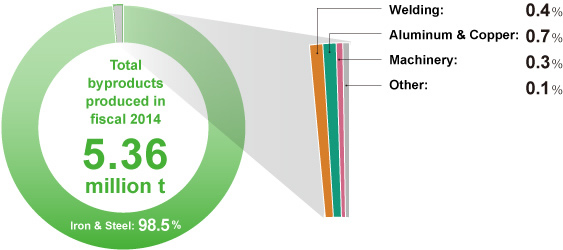
Byproducts, Amount Recycled and Recycling Ratio (Kobe Steel)
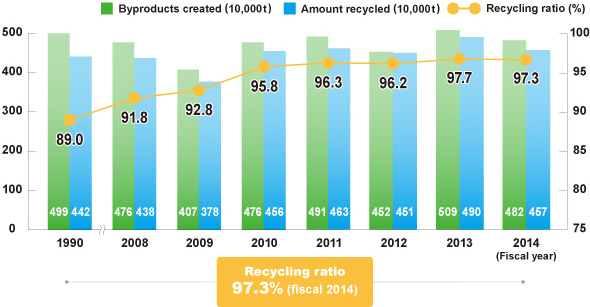
Recycling Initiatives
![]()
In each business unit and at each location we implement action programs to reduce levels of waste consigned to landfills, and aim for even greater levels of added value through measures to reduce and reuse waste, develop recycling technologies, and create new avenues for use.
Iron & Steel Business
(includes Domestic and Overseas Group Companies)
![]()
Recycling of Waste and Byproducts
![]()
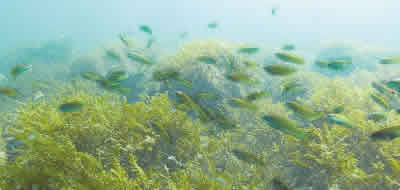
Seaweed growing on slag
breakwater, with fish
visiting area
(Iwaya Port, Awaji Island)
Kobe Steel continues to develop new technologies for the recycling of steel slag and dust as well as new uses for recycled material. As a result, in fiscal 2014 Kobe Works, Kakogawa Works and Takasago Works limited waste consigned to landfills to approximately 80,000 tons.
Through operation of a newly established hot-metal treatment plant, Kakogawa Works has reduced the amount of slag produced per unit.
In fiscal 2014, 2.47 million tons of blast furnace slag1 and 1.08 million tons of steelmaking slag1 were produced at Kakogawa Works and Kobe Works.
As one new use for recycled slag, a submerged breakwater2 utilizing approximately 1,000 tons of slag was constructed at Awaji Island in Hyogo Prefecture in fiscal 2014, beginning a scheduled three-year demonstration test onthe validity of slag as a harbor material and its safety for oceans. Currently, tests have confirmed that sargassum (seaweed) is growing well and that fish are inhabiting the area.
1. Blast furnace slag, steelmaking slag: Products classified as iron and steel slag, produced in the blast furnace and the steelmaking processes, respectively.
2. Submerged breakwater: An underwater structure to protect shorelines from the force of waves.
Aluminum & Copper Business
(includes Domestic and Overseas Group Companies)
![]()
Drawing on the cutting-edge initiatives for controlling waste that are in place at individual locations, the Aluminum & Copper Business pursues horizontal development at its locations that aim to raise the resource recycling rate of the business unit as a whole.
Measures include recycling of arc furnace ash at the Moka Plant, improvement of the copper recovery rate at Chofu Works and utilization of waste alkaline for wastewater treatment facilities at the Daian Plant. At Shinko Aluminum Wire Co., Ltd. we are working to reduce waste oil through the recycling and reuse of used oil. Additionally, Chofu Works continues to implement proactive measures to maintain its zero emissions status. As a result, it has achieved a recycling ratio of 99.9 percent.
At Kobe Precision Technology Sdn. Bhd. (Malaysia), meanwhile, we are working to reduce the volume of aluminum-containing waste through improvements to productivity and stronger measures to prevent contamination by foreign substances.
Recycling Ratio (Moka Plant)
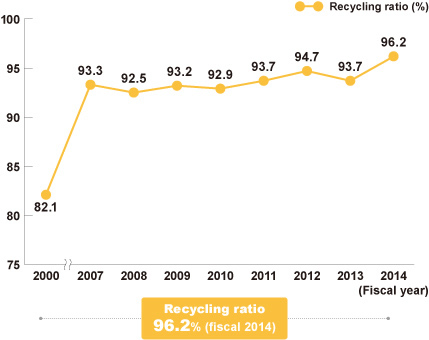
Recycling Ratio (Chofu Works)
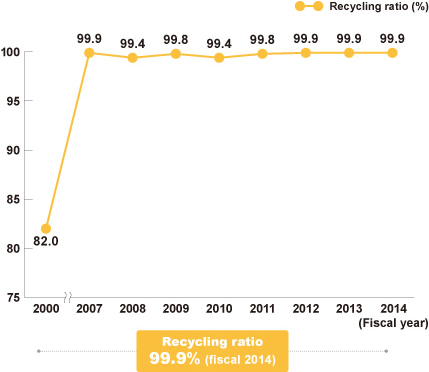
Welding Business
(includes Domestic and Overseas Group Companies)
![]()
The Welding Business pursues a variety of measures to identify waste and set targets for waste reduction at each of its locations. The know-how behind such measures is shared throughout the business via regular meetings.
At the Ibaraki Plant we are working to reduce waste oil through improvements to oil coating equipment. We are also promoting the use of recycled abrasive sand and waste flux (as cement materials, roadbeds, etc.) at the Fujisawa and Saijo plants. Additionally, we are pursuing the reuse of waste hydrochloric acid and oil at the Fukuchiyama Plant.
At Kobelco Welding of Europe B.V. (Netherlands) we are working to reduce waste through application of recycled lubricants and conversion to spools and product containers that utilize environmentally friendly materials.
Machinery Business
(includes Domestic and Overseas Group Companies)
![]()
In the Machinery Business, a high resource recycling ratio is maintained through the careful solidification of previously enacted measures.
The Takasago Machinery Center, which produces industrial machinery such as nonstandard compressors, has been aggressively introducing measures to reduce waste (from the source) and increase recycling. Additionally, the Harima Plant, which produces standard compressors, maintains zero waste consigned to landfills through recycling measures such as the introduction of returnable containers for product packing.
Kobelco Compressors Manufacturing Indiana, Inc. (USA), meanwhile, reduces waste by reusing machining equipment coolant and cutting fluid.
Topics
Measures to Reduce Waste at Kobelco Research Institute, Inc.
Kobelco Research Institute Inc.—which carries out services such as materials analysis, environmental analysis and target material manufacturing—reduces waste by incorporating a variety of individually small improvements and measures into their operations. For instance, used mictrotome knives (for microscopic sample preparation) are sharpened and reused, sample preparation tools are washed and reused, and container waste is reduced through bulk purchasing of reagents. These and other activities contribute to the accumulation of small improvements and ingenuity in day-to-day operations. By proactively sharing information between company sites and horizontally expanding activities throughout the company, we have achieved significant results.


